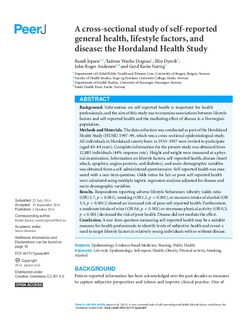| dc.contributor.author | Jepsen, Randi | |
| dc.contributor.author | Dogisso, Tadesse Washo | |
| dc.contributor.author | Dysvik, Elin | |
| dc.contributor.author | Andersen, John Roger | |
| dc.contributor.author | Natvig, Gerd Karin | |
| dc.date.accessioned | 2015-04-08T12:00:37Z | |
| dc.date.accessioned | 2015-11-24T14:03:19Z | |
| dc.date.available | 2015-04-08T12:00:37Z | |
| dc.date.available | 2015-11-24T14:03:19Z | |
| dc.date.issued | 2014-10 | |
| dc.identifier.citation | Jepsen et al. (2014), A cross-sectional study of self-reported general health, lifestyle factors, and disease: the Hordaland Health Study. PeerJ 2:e609 ; DOI 10.7717/peerj.609PeerJ 2014, 2:e609:1-14 | nb_NO |
| dc.identifier.issn | 2167-8359 | |
| dc.identifier.uri | http://hdl.handle.net/11250/2365527 | |
| dc.description | The article was originally published in PeerJ and distrubted under Creative Commons CC-BY 4.0. See DOI 10.7717/peerj.609 | nb_NO |
| dc.description.abstract | Background.
Information on self-reported health is important for health
professionals, and the aim of this study was to examine associations between lifestyle
factors and self-reported health and the mediating effect of disease in a Norwegian
population.
Methods and Materials.
The data collection was conducted as part of the Hordaland
Health Study (HUSK) 1997–99, which was a cross-sectional epidemiological study.
All individuals in Hordaland county born in 1953–1957 were invited to participate
(aged 40–44 years). Complete information for the present study was obtained from
12,883 individuals (44% response rate). Height and weight were measured at a physical examination. Information on lifestyle factors, self-reported health, disease (heart
attack, apoplexy, angina pectoris, and diabetes), and socio-demographic variables
was obtained from a self-administered questionnaire. Self-reported health was measured with a one-item question. Odds ratios for fair or poor self-reported health
were calculated using multiple logistic regression analyses adjusted for disease and
socio-demographic variables.
Results.
Respondents reporting adverse lifestyle behaviours (obesity (odds ratio
(OR) 1.7,
p
<
0
.
001), smoking (OR 1.2,
p
<
0
.
001), or excessive intake of alcohol (OR
3.3,
p
<
0
.
001)) showed an increased risk of poor self-reported health. Furthermore,
a moderate intake of wine (OR 0.6,
p
<
0
.
001) or strenuous physical activity (OR 0.5,
p
<
0
.
001) decreased the risk of poor health. Disease did not mediate the effect.
Conclusion.
A one-item question measuring self-reported health may be a suitable
measure for health professionals to identify levels of subjective health and reveal a
need to target lifestyle factors in relatively young individuals with or without disease. | nb_NO |
| dc.language.iso | eng | nb_NO |
| dc.publisher | PeerJ Inc. | nb_NO |
| dc.relation.uri | https://peerj.com/articles/609/ | |
| dc.rights | Navngivelse 3.0 Norge | * |
| dc.rights.uri | http://creativecommons.org/licenses/by/3.0/no/ | * |
| dc.subject | Hordaland health study | nb_NO |
| dc.subject | epidemiologi | nb_NO |
| dc.subject | evidence based medicine | nb_NO |
| dc.subject | sykepleie | nb_NO |
| dc.subject | obesity | nb_NO |
| dc.subject | fedme | nb_NO |
| dc.subject | public health | nb_NO |
| dc.subject | folkehelse | nb_NO |
| dc.subject | røyking | nb_NO |
| dc.subject | alkohol | nb_NO |
| dc.title | A cross-sectional study of self-reported general health, lifestyle factors, and disease: the Hordaland Health Study | nb_NO |
| dc.type | Journal article | nb_NO |
| dc.date.updated | 2015-04-08T12:00:37Z | |
| dc.subject.nsi | VDP::Medisinske fag: 700::Helsefag: 800::Samfunnsmedisin, sosialmedisin: 801 | nb_NO |
| dc.subject.nsi | VDP::Midical sciences: 700::Health sciences: 800::Community medicine, social medicine: 801 | nb_NO |
| dc.source.journal | PeerJ | nb_NO |
| dc.identifier.doi | 10.7717/peerj.609 | |
| dc.identifier.cristin | 1160820 | |
| dc.relation.project | Hordaland Health Study (HUSK) 1997–99 | nb_NO |

